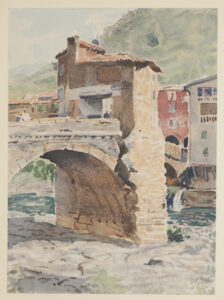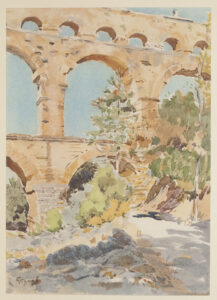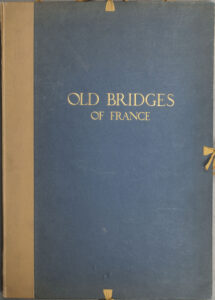This survey of French bridges was printed in France in an edition of 1000 by the American Institute of Architects. MIT’s copy is number 841.
It’s tied prettily with three golden cloth ribbons – a charming but practical feature, since the folio pages are not bound, and could otherwise become separated from the volume. That’s one reason why this book and others like it (whether because of age, scarcity, or fragility) are shelved in the secure and climate-controlled Limited Access Collection of MIT’s Rotch Library.
The frontispiece quotes Paul Séjourné (a French engineer who was awarded the Legion of Honor in 1886 for his work on railroad lines and masonry bridges): “Let us respect our old bridges … It  is an evil deed to destroy a monument, the fruit of the labors of our fathers … We should respect these monuments that have endured through the ages, especially in our own land. Let us be faithful to the Past, which is the foundation of the Present and the guarantee of the Future.”
is an evil deed to destroy a monument, the fruit of the labors of our fathers … We should respect these monuments that have endured through the ages, especially in our own land. Let us be faithful to the Past, which is the foundation of the Present and the guarantee of the Future.”
Yes, even in 1925, there were individuals with the foresight to defend the old and beautiful from the encroachments of the new and improved. (By way of contrast, just consider: New York continues to mourn the loss of its original Pennsylvania Station, while Boston still grieves over its experiment with urban renewal in what was once an actual neighborhood known as the West End.)
 Old Bridges has a short preface by Victor Laloux, a Beaux-Arts architect whose most famous building is probably the Gare d’Orsay (now the Musée d’Orsay). Laloux addresses the book’s authors, architects William Emerson and Georges Gromort, two of his former students, with a passage worthy of Cicero: “Your book appeals at once to our confrères; but one feels also its constant intention to reveal to the amateur and, doubtless, also to the traveler, whether foreign or French, beauties which, being hidden in the smaller towns far from the travelled roads, would otherwise escape him. If your work does no more than persuade some artists to visit towns like Cahors, or Albi, or to roam through the regions of Languedoc and Provence, where you note so many bridges of interest, you will doubtless feel that neither your time nor trouble was wasted, and that at least one of the objects you may have had in mind is fully attained.”
Old Bridges has a short preface by Victor Laloux, a Beaux-Arts architect whose most famous building is probably the Gare d’Orsay (now the Musée d’Orsay). Laloux addresses the book’s authors, architects William Emerson and Georges Gromort, two of his former students, with a passage worthy of Cicero: “Your book appeals at once to our confrères; but one feels also its constant intention to reveal to the amateur and, doubtless, also to the traveler, whether foreign or French, beauties which, being hidden in the smaller towns far from the travelled roads, would otherwise escape him. If your work does no more than persuade some artists to visit towns like Cahors, or Albi, or to roam through the regions of Languedoc and Provence, where you note so many bridges of interest, you will doubtless feel that neither your time nor trouble was wasted, and that at least one of the objects you may have had in mind is fully attained.”
After perusing the text with its beautiful line drawings by Louis C. Rosenburg and Samuel  Chamberlain, along with the twenty-four watercolor plates by Pierre Vignal (which often disappear from books of this sort), the reader will no doubt come to agree with Monsieur Laloux. This is a work that will interest not only the scholar or connoisseur of bridges – whether architect, engineer or historian – but also the “common reader” who simply appreciates beauty in the built environment.
Chamberlain, along with the twenty-four watercolor plates by Pierre Vignal (which often disappear from books of this sort), the reader will no doubt come to agree with Monsieur Laloux. This is a work that will interest not only the scholar or connoisseur of bridges – whether architect, engineer or historian – but also the “common reader” who simply appreciates beauty in the built environment.



